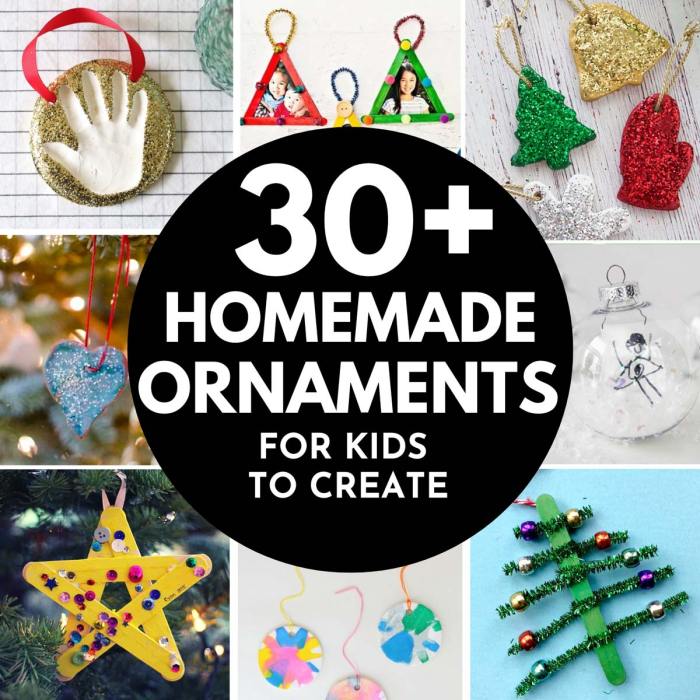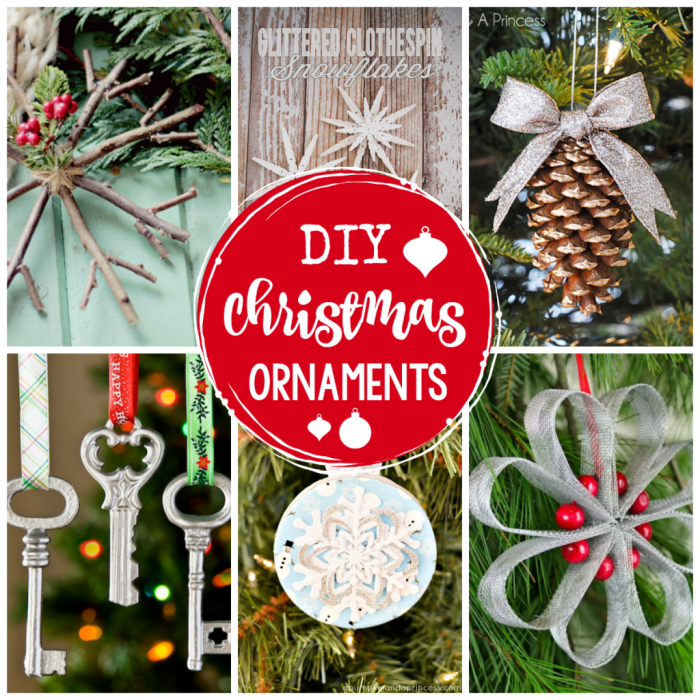Easy DIY Christmas Bauble Techniques

Diy christmas bauble ideas – Creating unique and personalized Christmas baubles is a rewarding and affordable way to add a special touch to your holiday decorations. This section details simple techniques using readily available materials, perfect for crafting with family or enjoying a relaxing crafting session on your own. We’ll explore several methods, focusing on ease of execution and creative potential.
Simple Bauble Creation Using Readily Available Materials
These step-by-step instructions will guide you through creating charming baubles using common household items. The simplicity of these methods allows for easy customization and adaptation to suit individual preferences.
- Pom-Pom Baubles: Gather colorful yarn scraps, a balloon (slightly smaller than your desired bauble size), and PVA glue. Inflate the balloon to the desired size. Wrap the yarn around the balloon, ensuring even coverage, applying glue as you go. Allow to dry completely. Once dry, gently pop the balloon and remove it from the yarn structure.
You now have a fluffy pom-pom bauble! Add a ribbon or string for hanging.
- Paper Baubles: Use colorful cardstock, scissors, glue, and ribbon. Cut out various shapes (stars, snowflakes, circles) from the cardstock. Arrange them in a pleasing pattern on a styrofoam ball or a deflated and carefully secured balloon. Secure the shapes using glue. Once dry, add a ribbon for hanging.
For a more sophisticated look, use patterned paper or scrapbook paper.
- Fabric Scrap Baubles: Select small pieces of fabric in festive colors and patterns. Cut them into squares or circles slightly larger than your desired bauble size. Glue the fabric pieces onto a styrofoam ball, overlapping slightly to create a textured effect. Once dry, add a ribbon for hanging. Consider using felt for a more structured and less frayed look.
Decorating Plain Glass Baubles
Plain glass baubles provide a blank canvas for creative expression. These techniques offer unique ways to transform simple baubles into personalized ornaments.
- Glitter Baubles: Apply a layer of Mod Podge or a similar adhesive to the surface of the glass bauble. Generously sprinkle glitter over the adhesive, ensuring even coverage. Allow to dry completely, then gently shake off any excess glitter. For a more textured effect, layer different colors of glitter.
- Painted Baubles: Use acrylic paints to create intricate designs or simple patterns on your glass baubles. Allow each layer of paint to dry completely before adding another. Consider using stencils for more precise designs. Seal the paint with a clear varnish for a durable finish. You could paint scenes, abstract designs, or simple stripes.
- Decoupage Baubles: Cut out images from magazines, napkins, or printed paper. Apply a layer of Mod Podge to the surface of the bauble. Carefully place the image onto the adhesive, smoothing out any wrinkles. Apply another layer of Mod Podge over the image to seal it. Allow to dry completely.
This method allows for personalized images and messages.
Creating Baubles Using Recycled Materials, Diy christmas bauble ideas
Repurposing materials adds a unique and eco-friendly element to your Christmas decorations. These examples showcase how to transform everyday items into festive baubles.
- Button Baubles: Gather a variety of buttons in different shapes, sizes, and colors. Glue the buttons onto a styrofoam ball, creating a colorful and textured bauble. Fill any gaps between the buttons with smaller buttons or beads. Add a ribbon for hanging. This technique is ideal for using up leftover buttons.
Crafting DIY Christmas bauble ideas offers a fantastic way to personalize your holiday decorations. For a unique twist, consider incorporating natural elements; a great resource for inspiration is this guide on diy seashell Christmas ornaments , showcasing beautiful and eco-friendly options. Returning to more general bauble ideas, remember to explore various materials and techniques to create truly one-of-a-kind festive adornments.
Intermediate DIY Christmas Bauble Projects

Stepping up from the basics, these intermediate projects allow for more creative expression and the incorporation of finer details. They require a bit more patience and precision, but the results are well worth the effort. These projects utilize a range of techniques to achieve unique and visually appealing baubles.
Frosted Glass Baubles with Intricate Stenciling
These baubles mimic the look of professionally-made frosted glass ornaments. The technique combines the simplicity of spray paint with the detail of stenciling.
To create these, start with clear glass baubles. Lightly sand the surface for better paint adhesion. Apply a coat of frosted glass spray paint, allowing it to dry completely. Then, using stencils of your choice (holiday motifs, snowflakes, etc.), apply a contrasting metallic paint (gold, silver, or copper) using a sponge brush to avoid bleeding. Seal with a clear acrylic sealer for durability and longevity. Experiment with layering stencils for complex designs.
Beaded and Wire-Wrapped Baubles
This project utilizes wire-wrapping techniques to create a unique, textured surface, embellished with beads.
Begin by selecting your beads – consider a variety of colors, sizes, and shapes for visual interest. Use thin, flexible wire (jewelry wire works well) to wrap around the bauble, securing the beads at intervals. You can create patterns, geometric designs, or even wrap the entire bauble in a spiral. For added sparkle, incorporate small crystals or iridescent beads. Secure the ends of the wire neatly and hide them within the beading.
Decoupage Baubles with Layered Paper
This project uses decoupage to create layered, textured baubles with a vintage or scrapbook feel.
Choose decorative papers – scrapbook paper, vintage maps, sheet music, or even patterned napkins work beautifully. Cut out shapes and images, layering them on the bauble’s surface. Apply decoupage medium (Mod Podge or a similar product) to adhere the paper and seal the layers. You can add embellishments like glitter, ribbons, or small charms between the layers for added texture and visual depth. Remember to apply several coats of decoupage medium to protect the finished bauble.
Techniques for Adding Intricate Details
Adding intricate details elevates a simple bauble to a unique work of art. Painting requires a steady hand and fine brushes for precise lines and shading. Decoupage allows for the incorporation of various textures and patterns through layered paper and embellishments. Beading, as seen in the beaded and wire-wrapped baubles, provides a three-dimensional texture and sparkle. Experiment with different mediums and techniques to discover your own unique style.
Comparing Textured Bauble Creation Methods
Two distinct methods for creating textured baubles are using textured paints and employing a layering technique with various materials. Textured paints, such as crackle paints or those with added glitter, offer a quick and easy way to add texture. The effect is relatively uniform across the bauble’s surface. In contrast, the layering technique, as seen in the decoupage project, allows for a more varied and complex texture, combining different materials and creating depth.
The layering method offers more control over the final texture and allows for greater creativity in design. Both methods offer unique aesthetic qualities, making the choice a matter of personal preference and the desired final look.
Advanced DIY Christmas Bauble Designs

Creating truly stunning Christmas baubles requires venturing beyond basic techniques. This section explores three advanced designs, demanding patience and precision but yielding uniquely beautiful results. These projects showcase more complex techniques and the use of a wider variety of materials, offering a rewarding challenge for experienced crafters.
Intricate Beaded Baubles
This project involves meticulously covering a clear glass bauble with tiny beads, creating a dazzling, three-dimensional effect. The process begins by carefully cleaning the bauble surface. A strong adhesive, such as a specialized glass adhesive or a high-quality craft glue, is then applied in small sections. Individual beads are carefully placed onto the adhesive, ensuring complete coverage and avoiding gaps.
Depending on the desired design, beads can be arranged in patterns, gradients, or randomly for a more organic look. Patience is key; this process can be time-consuming, but the result is a shimmering, luxurious bauble. Using different sizes and colours of beads adds further complexity and visual interest. Consider using seed beads for a more delicate appearance, or larger,faceted beads for a bolder statement.
Resin-Encased Botanical Baubles
These baubles capture the beauty of nature by encasing pressed flowers, leaves, or other botanical elements in resin. Start by carefully pressing your chosen botanicals between heavy books for several days to remove moisture and flatten them. Select a high-quality resin designed for crafting, following the manufacturer’s instructions carefully. Mix the resin according to the instructions, ensuring no air bubbles are trapped.
Carefully arrange the pressed botanicals inside a clear, glass bauble. Slowly pour the resin into the bauble, ensuring the botanicals are fully submerged and no air bubbles are visible. Allow the resin to cure completely, according to the manufacturer’s instructions. This process requires careful handling to prevent damage to the delicate botanicals and to avoid air bubbles in the finished product.
The final result is a unique, nature-inspired bauble with a captivating depth and texture.
Hand-Painted Porcelain Baubles
Hand-painting porcelain baubles allows for intricate designs and personalized touches. Begin with blank, white porcelain baubles. Use high-quality porcelain paints, designed to withstand firing in a kiln. Sketch your design lightly onto the bauble surface using a pencil. Then, carefully paint the design using thin, even coats of paint, allowing each coat to dry completely before applying the next.
Once the painting is complete, the baubles need to be fired in a kiln to permanently set the paint. This step requires access to a kiln and understanding of proper firing temperatures. Detailed designs, such as landscapes or intricate patterns, require considerable artistic skill and patience. The finished baubles are durable, beautiful, and truly one-of-a-kind.
| Project Name | Description |
|---|---|
| Intricate Beaded Baubles | Covering a clear glass bauble with meticulously placed beads for a dazzling effect. |
| Resin-Encased Botanical Baubles | Encasing pressed flowers and leaves in resin to create a unique, nature-inspired bauble. |
| Hand-Painted Porcelain Baubles | Creating intricate designs on blank porcelain baubles using porcelain paints and kiln firing. |
Challenges and Rewards of Complex Bauble Designs
More complex bauble designs present unique challenges, requiring advanced skills, specialized tools, and considerable patience. The intricate nature of these projects demands meticulous attention to detail and a high level of precision. However, the rewards are substantial. The finished products are unique, highly personalized, and showcase a level of craftsmanship that simpler designs cannot match. The sense of accomplishment derived from completing a challenging project is also a significant reward.
These advanced baubles become treasured keepsakes, showcasing not only artistic skill but also the dedication and effort invested in their creation.
Questions and Answers: Diy Christmas Bauble Ideas
Can I use recycled materials for my baubles?
Absolutely! Many recycled materials, like glass jars, buttons, and cardboard, can be transformed into unique and charming baubles.
How can I preserve my handmade baubles?
Proper sealing (if applicable) and careful storage in a cool, dry place will help maintain their beauty for years to come.
What if my bauble breaks during the crafting process?
Don’t despair! Depending on the material, you may be able to repair it or adapt your design to incorporate the damage. Consider it a unique characteristic!
How long does it typically take to make a DIY Christmas bauble?
This varies greatly depending on the complexity of the design and your experience level. Simple baubles can be made in an hour or less, while more intricate projects might take several hours or even days.
